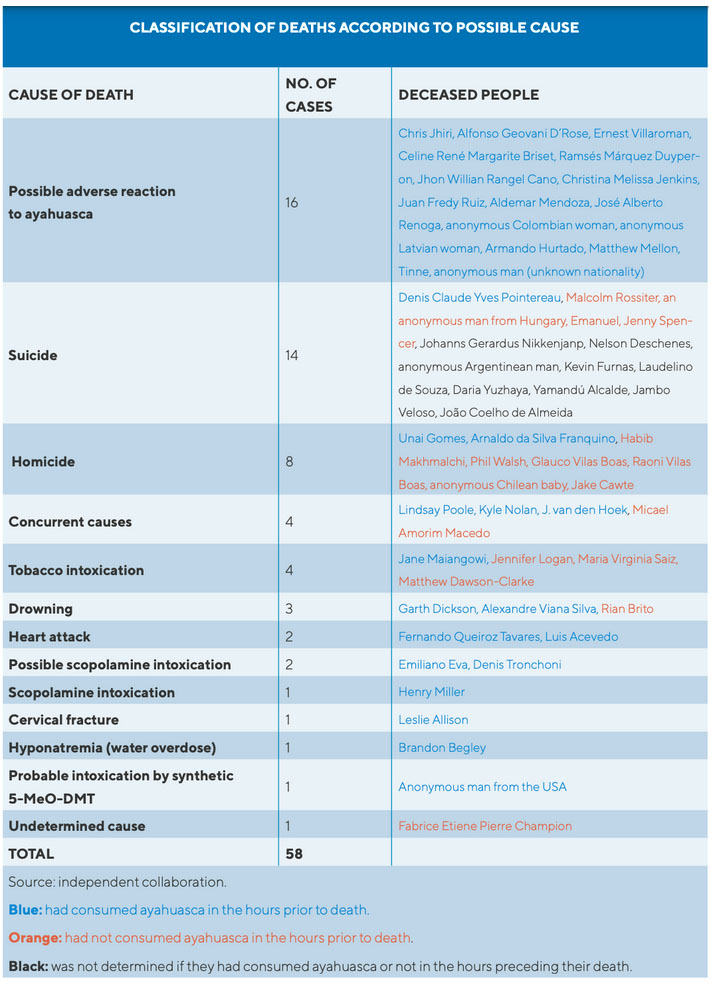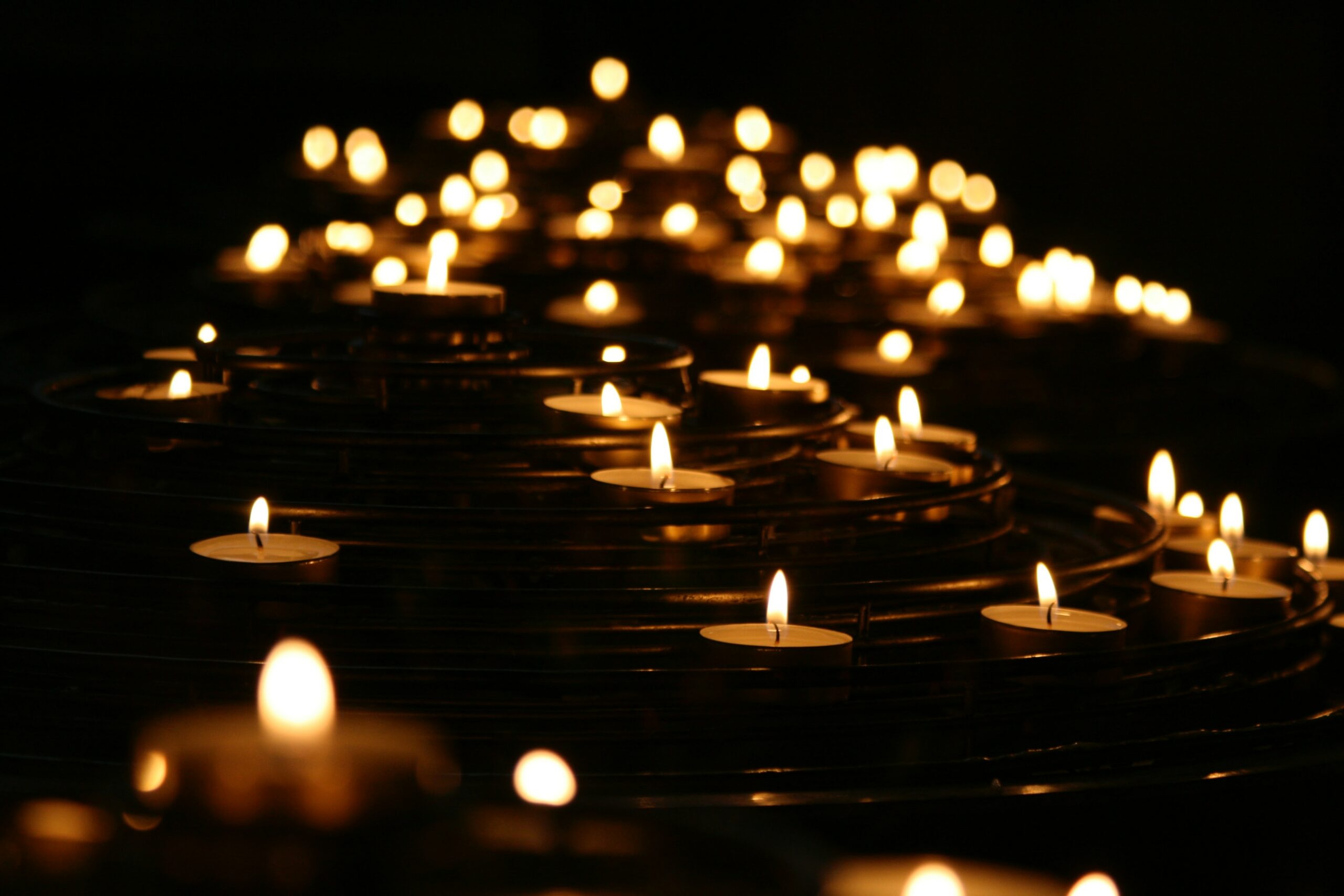Carlos Suárez Álvarez | 21 August 2023
Kyle Nolan was 18 when he traveled to Peru in search of spiritual awakening and died. Jane Maiangowi passed away at age 70 while participating in a cleansing ritual officiated by an Amazonian shaman in Canada. British tourist Unai Gomes was killed by a fellow retreat participant in Iquitos. And a man named Emanuel died by suicide in the Netherlands by throwing himself under the wheels of a train. People have died in the Amazon and in large cities in South America, Australia, Europe, and North America. Fifty-eight tragedies attributed to ayahuasca between 2010 and 2022 left families distraught and friends bereaved. What exactly happened?
The mainstream media seemed to have it pinpointed: ayahuasca was the cause of these 58 fatalities. And ayahuasca’s mention in the headline offered undeniable clickbait from a journalistic point of view. After all, a headline linking death to an “exotic and hallucinogenic drug” will likely gain many more readers.
An Indirect Relationship
Can any of these deaths be attributed to ayahuasca directly? And if so, to what degree? We intended to answer these questions by examining everything published globally (from anti-drug blogs, scientific articles, to general news websites). We compiled the most comprehensive list of ayahuasca-associated deaths to date. And this research, presented in detail in this report, allows us to draw a primary conclusion.
At the time of this writing, no toxicological analysis or forensic examination has determined that ayahuasca caused a single death by acute intoxication by consuming the traditional brew of Banisteriopsis caapi and Psychotria viridis or Diplopterys cabrerana. The majority of deaths could have been avoided if the experiences had followed the minimum safety standards, the sessions had been supervised, and the experiences had been integrated afterward.
The information available suggests that only 34 out of the 58 cases were able to confirm that the individuals had consumed ayahuasca in the hours prior to their death. And of these 34 cases, none of the nine autopsies made public attributed the cause of death to ayahuasca. The following graph breaks down the cases in detail:

We know that ayahuasca is physiologically safe for those in good health. According to Robert S. Gable, a psychologist and expert in recreational drug toxicity, the amount of ayahuasca needed to produce death by poisoning is 20 times the dose needed to induce psychoactivity. Alcohol is 10 times greater than its psychoactive dose and cocaine is 15 times more. Anyone who has experienced ayahuasca knows that it is practically impossible to take 20 times the psychoactive dose because of its unpleasant taste and emetic properties. Even if someone managed to drink that amount, they would vomit before experiencing any poisoning effects.
However, ayahuasca does come with certain risks. Like any medicine, there can be contraindications for some individuals who should avoid its use. Serious illnesses, cardiovascular problems, a history of psychiatric disorders like schizophrenia, and mixing certain drugs and medications (such as antidepressants) are contraindicated with ayahuasca.
After clarifying this, what caused the 58 deaths that the media attributed to ayahuasca?
A Reaction or Adverse Event?
In the 16 cases where there was a short time frame between taking ayahuasca and death, the available information did not allow us to determine the cause. It is possible that there was an adverse reaction to ayahuasca which led to the person’s death. But the information on these cases is limited. We do not know, for example, if the deceased had a cardiovascular problem or if they were simultaneously taking a contraindicated medication.
It is also possible that in some of these 16 cases, there was not a reaction but rather an adverse event. This could be a fatality occurring under the influence of a substance when performing an activity, for example, a car accident while under the influence of a sleeping pill. For example, Alfonso Geovani D’Rose retired to his cabin after participating in a ceremony at a resort. He was found dead on the bathroom floor the next day. One of the newspaper articles suggested that he had collapsed and hit his head.
Heart Issues
In two cases, autopsies established that a heart attack was the cause of death. Luis Acevedo, a 33-year-old from Chile, suffered a heart attack hours after taking ayahuasca. Is it possible that Acevedo suffered from some kind of cardiovascular problem that ayahuasca aggravated? If so, the autopsy did not determine this. In another example, Fernando Henrique Queiroz Tavares, a 19-year-old from Brazil, suffered from Marfan Syndrome (a degenerative heart disease). Perhaps this was the determining factor in his death. The autopsy reported he died from a tear in the aorta artery at the end of an ayahuasca ritual. However, Tavares had taken ayahuasca for three years previously without any issues.
Tobacco Poisoning and Water Intoxication
Ayahuasca has never been directly implicated in the autopsies that determined death due to intoxication. In 4 of the 58 cases, tobacco seems to have been the direct cause of death. This was certain when an autopsy was performed. Jane Maiangowi took ayahuasca in addition to a tobacco infusion as did Matthew Dawson-Clarke in a retreat center in Iquitos. In addition, the available information indicates that tobacco was implicated in the deaths of Argentinean María Virginia Saiz and Canadian Jennifer Logan.
The young Henry Miller died from scopolamine intoxication. It is possible that this was also what happened to Emiliano Eva and Denis Tronchoni, who visited an Achuar community in the Ecuadorian jungle where they took ayahuasca blended with Brugmansia species. Another death in the United States seems to have been the result of an overdose of synthetic 5-MeO-DMT, which was taken hours after ayahuasca. Finally, Brandon Begley died during an ayahuasca ceremony from hyponatremia, an excessive dilution of blood sodium values as a result of overhydration. In other words, Begley died from having too much water.
Suicides and Homicides
The media linked fourteen suicide cases to the consumption of ayahuasca. However, in only one of the cases was it reported that the deceased took ayahuasca in the hours prior. The media’s reaction to a young Dutchman’s death is representative. Ayahuasca trip leads to suicide: “My son thought he was being controlled by aliens” was the headline of the digital news program RTL Nieuws. However, it was never proven that Emanuel ever tried ayahuasca. Additionally, the young man suffered from serious mental health problems and consumed various psychoactive substances. Establishing a causal relationship between ayahuasca and any of the other thirteen suicides is speculative.
The situation is similar concerning homicides. Out of the eight murders linked to ayahuasca, the killer was under its effects in two of them. In two of the cases that took place in Australia (Jake Cawte and Phil Walsh), the murderers suffered from severe psychiatric disorders and they took ayahuasca months before they committed the murder. To what extent the consumption aggravated their illness is unknown. What is clear, according to the Ayahuasca Technical Report published by ICEERS, is that ayahuasca is contraindicated for people with severe psychiatric disorders, and especially for those with a tendency towards psychosis.
Other Circumstances
In the remaining nine cases, any connection between ayahuasca and death can be ruled out or there were circumstances that could have independently caused the fatal outcome. Fabrice Champion died in a retreat center in Iquitos. He was already seriously ill while traveling and did not have ayahuasca the night of his death. Rian Brito had not had any ayahuasca when he drowned in the sea. Garth Dickson and Alexandre Viana Silva drowned after taking ayahuasca. But their deaths could have been avoided with judicious supervision by the organizers of the session.
Proper supervision could have potentially prevented the death of Leslie Allison, caused by a cervical fracture resulting from the convulsions she experienced while in a trance state. The passing of Kyle Nolan, Micael Amorim Macedo, J. van den Hoek, and Lindsay Pole involved additional circumstances beyond ayahuasca that could have potentially caused death independently.
A Dangerous Drug of Globalization?
Each death explored in this report is a tragedy. It is not the intention to minimize the importance of these losses. The goal is to elucidate whether taking ayahuasca implies a statistically significant risk. According to a parallel investigation (detailed results can be found in the full report), we have estimated that more than four million people have taken ayahuasca at some time in their lives. And 820,000 people did so in 2019, a year that around five and a half million servings were consumed. The media linked five deaths to ayahuasca that year. However, no autopsy in any of these cases determined that their deaths were caused by ayahuasca intoxication. It is very likely that all of them could have been avoided if the medicine had been consumed in a context with minimum safety standards.
The social alarm that these deaths trigger when they are published in the media can be put into perspective. An investigation by the University of Oxford attributed 3,000 deaths a year to the daily consumption of aspirin in the United Kingdom alone. The World Health Organization reports three million deaths from alcohol globally each year. On the other hand, scientific research has uncovered the therapeutic and spiritual potential of ayahuasca. An ICEERS study coordinated by Maja Kohek revealed that participants in ayahuasca ceremonies in the Netherlands generally have better health than the national average, confirming the positive impact suggested by its long history in shamanic healing contexts and ayahuasca churches.
While the media has linked ayahuasca to 58 fatalities, a detailed analysis of the data indicates that no autopsy or toxicological examination has directly attributed any death to acute intoxication from the traditional ayahuasca brew. The cases with a potential connection to ayahuasca were limited, often involving other substances, pre-existing health conditions, or other circumstances.
The media portraying ayahuasca as dangerous should be put into perspective when compared to other substances with higher death rates. Ayahuasca’s therapeutic potential and positive impact on well-being have been demonstrated in scientific research. Balanced reporting, harm reduction measures, and responsible practices are essential to fostering a comprehensive understanding of this sacred plant medicine.
Read more about the findings in the Executive Summary of Ayahuasca, Global Consumption & Reported Deaths in the Media. You can request the full 196-page report (available only in Spanish) here.
Further Reading
- Research Highlight: Four Million People Have Taken Ayahuasca Worldwide
- Ayahuasca, Global Consumption & Reported Deaths in the Media
- Health Status of Ayahuasca-Ceremony Participants in the Netherlands
- Ayahuasca In Spain
Photo by Mike Labrum on Unsplash.
Categories:
Ayadeath Report
, NEWS
Tags:
ayahuasca
, adverse effects
, death
, media
, journalism

